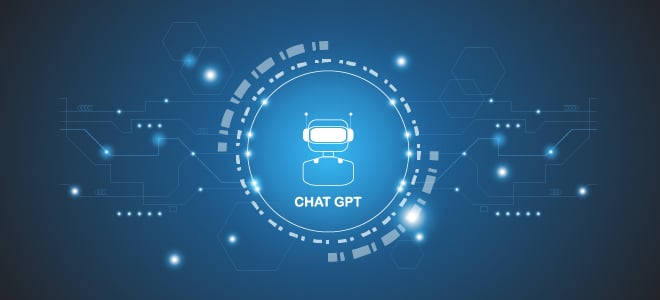AI can be used in education in various ways. Students can use it to get answers for homework and other schoolwork or as a tool that supports their learning. This can be done through chatbots or virtual tutors who answer real-time questions.
Artificial intelligence in education can analyze student data from tests, quizzes, and homework to understand what concepts students struggle with or which ones they excel at.
Want to know how AI can change the marketing industry? Check out our blog on AI in the marketing industry for more information.
What is ChatGPT?
ChatGPT is a chatbot that can answer any queries related to any topic. It can write programs and provide solutions.
ChatGPT works on the premise that every query has a solution and will find it for you. The bot has an AI model to detect problems and provide real-time solutions. You don’t have to wait for answers—they’re already there!
The beauty of ChatGPT is that it goes beyond providing answers; it writes code for you based on your input.
Want to know the different types of machine learning algorithms? Check out our blog on machine learning methods for more information.
Impact of AI on Higher Education
AI is a game-changer. And it’s not just for the business world—it’s also changing how we learn and teach.
By 2030, AI is predicted to contribute as much as $15.7 trillion to the global economy—more than China and India’s combined output.
Advantages of AI in Higher Education
- Enhanced learning environments for students
AI in education can help create more personalized student experiences by providing customized content, recommendations, assessments, and virtual tutoring instructions based on their individual goals, preferences, and habits.
- Improved student engagement and satisfaction
Chatbots can be used to engage students who are looking for opportunities to learn more about a particular subject or course. This allows universities to reach out to potential students through multiple channels such as social media, emails, etc., thereby improving student engagement and satisfaction.
- Enhanced data-driven decision-making processes
The role of artificial intelligence in education has helped universities make better decisions based on data analysis and predictive analytics. This has resulted in increased efficiency of operations such as admissions management and staff management, leading to improved outcomes for students and staff members!
- Improved information retrieval
AI chatbots in higher education can search for and retrieve academic data. This can include everything from academic journals to textbooks. The bot can then present the information in a more easily understandable way by students and faculty members.
- Reduced costs
Chatbots are a cost-effective way to reduce the number of human employees needed to support students and faculty. By automating repetitive tasks, chatbots can help save money and time.
Want to know the difference between data science and machine learning? Check out our blog on Data science Vs. Machine Learning for more detailed information.
Drawbacks of AI in higher education
- They may not be able to learn from mistakes made by humans
The first drawback of using AI in higher education is that it may need help to learn from human mistakes. The problem with this is that if something goes wrong with the system, like if someone accidentally feeds it insufficient data, the results will be inaccurate.
- The AI system can be biased
Bias exists because the data that is fed into the chatbot is not neutral; it’s biased. This means that when the chatbot encounters a new situation, it will give you a response based on its past experiences, which its training data have influenced. This can lead to offensive results (e.g., if the chatbot was trained on racist data) or generally inaccurate results (e.g., if the chatbot was trained on biased data).
- The AI system could make mistakes because of human error
Human fault can lead to inaccurate results due to several technical factors, including:
- Faulty Algorithms
- Bugs and Malware
- Less Efficient Coding Languages
Want to know more about the tools used in machine learning? Check out our blog post on essential tools for machine learning!
- Accuracy
The next drawback of using AI for higher education is accuracy. Many studies have shown that AI can’t accurately predict the future of education and make predictions based on past data. This is especially true when predicting human behavior and emotions, which are very important in the classroom setting.
- AI cannot develop new ideas or perspectives on old ideas
Since AI is software and not a human, it cannot develop new ideas or perspectives on old ideas. While this may seem like a minor deal at first glance, it can be incredibly problematic when trying to teach students who are still learning to think critically about topics such as politics or history.
- AI would not be able to understand students’ learning styles
Students have different learning styles and need to be taught in a way that suits their specific learning styles. The AI program cannot do this since it relies on statistical data, meaning it cannot make any decisions based on the individual student’s needs.
- Students may feel isolated from one another
The last major drawback of using AI in higher education is that students may feel isolated from one another. If your program uses a virtual chatbot instead of real-life teachers, your students will never interact with real people!
Future of education
The future of education is AI, and it will be a game-changer for students and teachers alike.
As we move forward in this new era of technology, we will see more and more integration of artificial intelligence into our classrooms. AI can help teachers analyze student data over time to reveal patterns of behavior that would otherwise be invisible to the teacher. It can provide personalized learning based on each student’s needs, interests, and preferences. This could be done by analyzing student data over time to reveal patterns of behavior that would otherwise be invisible to the teacher.
Want to have more information on data science? Check out our blog on the pillars of data science for detailed information.
Pros And Cons Of AI
| Pros | Cons |
|---|---|
| Efficiency and accuracy | Uncontrollability |
| Effective data acquisition and analysis | Don’t have emotions |
| Reducing costs | Degradation (Unable to self repair ) |
| Improving human decision making | Reduced no. of jobs for humans |
| Mechanical advantage | High costs and lacks creativity |
| Understanding high dimensional data | Absence ethical considerations |
Conclusion
The DALL-E system uses artificial intelligence to compose images from textual descriptions. At the same time, Chat GPT allows users to type in questions about AI and then gets back to them with answers in seconds.
Want to make an AI that is more efficient than these AI’s? You can find variety of online learning programs in data science and machine learning at Online Manipal. Offered by the prestigious Manipal Academy of Higher Education (MAHE), online M.Sc in Data Science covers the advanced data science and machine learning methods and tools to help students to become significant in their professional lives. Whether you want to expand your knowledge or take your career to the next level, you can learn from industry leaders and become an expert in data science and machine learning!
Key takeaways:
- AI is changing the way students learn and interact with their teachers, which changes the overall experience of attending a university.
- It is also changing how universities teach their students, giving them more flexibility to focus on individualized learning.
- This new flexibility can be used for both positive and negative outcomes, but overall it will lead to better education for all students and teachers alike.
- Finally, AI can also help learn from past mistakes and ensure that they do not happen again, which helps create safer learning environments for everyone involved in higher education today!
Prepare for your next career milestone with us











